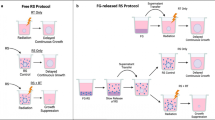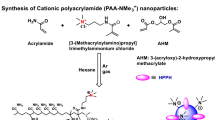Abstract
Fibrin glue (FG) has potential as a delivery vehicle for photosensitizer directly to the resection cavity, so it may bypass the blood-brain barrier (BBB) and increase the concentration of successfully delivered photosensitizer. A specialized form of photodynamic therapy (PDT), photochemical internalization (PCI), which involves both photosensitizer and chemotherapeutic agent internalization, can locally inhibit the growth of cells. This will allow the reduction of recurrence of malignant gliomas around surgical resection. This study will look at the efficacy of FG loaded with drugs in mediating both PDT and PCI in inhibiting 3-dimensional tumor spheroid growth in vitro. Experiments were conducted on spheroids comprised of F98 glioma cells using photosensitizer AlPcS2a and chemotherapeutic drug bleomycin (BLM). At 2-, 24-, 48-, and 72-h increments, supernatant covering an FG layer within a well was collected and replaced by fresh medium, then added to spheroid-containing wells, which contained the respective chemicals for PDT and PCI. The wells were then exposed to light treatment from a diode laser, and after, spheroid growth was monitored for a period of 14 days. Significant spheroid growth inhibition was observed in both PDT and PCI modalities, but was far greater in PCI. Additionally, complete growth suppression was achieved via PCI at the highest radiant exposure. Achieving a slow photosensitizer release, significant F98 spheroid inhibition was observed in FG-mediated PDT and PCI. The present study showed BLM-PCI was the most efficacious of the two modalities.





Similar content being viewed by others
References
Chamberlain MC (2011) Radiographic patterns of relapse in glioblastoma. J Neuro-Oncol 101:319–323
Dobelbower MC, Burnett OL III, Nordal RA, Nabors LB, Markert JM, Hyatt MD, Fiveash JB (2011) Patterns of failure for glioblastoma multiforme following concurrent radiation and temozolomide. J Med Imaging Radiat Oncol 55:77–81
Robertson CA, Hawkins Evans D, Abrahamse H (2009) Photodynamic therapy (PDT): a short review on cellular mechanisms and cancer research applications for PDT. J Photochem Photobiol B Biol 96:1–8
Abrahamse H, Hamblin MR (2016) New photosensitizers for photodynamic therapy. Biochem J 473:347–364
Berg K, Selbo PK, Prasmickaite L, Tjelle TE, Sandvig K, Moan J, Gaudernack G, Fodstad O, Kjølsrud S, Anholt H, Rodal GH, Rodal SK, Høgset A (1999) Photochemical internalization: a novel technology for delivery of macromolecules into cytosol. Cancer Res 59:1180–1183
Selbo PK, Weyergang A, Høgset A, Norum OJ, Berstad MB, Vikdal M, Berg K (2010) Photochemical internalization provides time-and space-controlled endolysosomal escape of therapeutic molecules. J Control Release 148:2–12
Mathews MS, Blickenstaff JW, Shih EC, Zamora G, Vo V, Sun CH, Hirschberg H, Madsen SJ (2012) Photochemical internalization of bleomycin for glioma treatment. J Biomed Opt 17:058001
Sultan AA, Jerjes W, Berg K, Høgset A, Mosse CA, Hamoudi R, Hamdoon Z, Simeon C, Carnell D, Forster M, Hopper C (2016) Disulfonated tetraphenyl chlorin (TPCS2a)-induced photochemical internalisation of bleomycin in patients with solid malignancies: a phase 1, dose-escalation, first-in-man trial. Lancet Oncol 17:1217–1229
Jerjes W, Theodossiou TA, Hirschberg H, Høgset A, Weyergang A, Selbo PK, Hamdoon Z, Hopper C, Berg K (2020) Photochemical internalization for intracellular drug delivery. From basic mechanisms to clinical research. J Clin 9:528
Vasilev A, Sofi R, Rahman R, Smith SJ, Teschemacher AJ, Kasparov S (2020) Using light for therapy of glioblastoma multiforme (GBM). Brain Sci 10:75
Cramer SW, Chen CC (2020) Photodynamic therapy for the treatment of glioblastoma. Front Surg 6:81
Madsen SJ, Angell-Petersen E, Spetalen S, Carper SW, Ziegler SA, Hirschberg H (2006) Photodynamic therapy of newly implanted glioma cells in the rat brain. Lasers Surg Med 38:540–548
Yoshida H, Yamaoka Y, Shinoyama M, Kamiya A (2000) Novel drug delivery system using autologous fibrin glue--release properties of anti-cancer drugs. Biol Pharm Bull 23:371–374
Spicer PP, Mikos AG (2010) Fibrin glue as a drug delivery system. J Control Release 148:49–55
Anai S, Hide T, Takezaki T, Kuroda J, Sinojima N, Makino K, Nakamura H, Yano S, Kuratsu J (2014) Antitumor effect of fibrin glue containing temozolomide against malignant glioma. Cancer Sci 105:583–591
Bastiancich C, Danhier P, Préat V, Danhier F (2016) Anticancer drug-loaded hydrogels as drug delivery systems for the local treatment of glioblastoma. J Control Release 243:29–42
Bastiancich C, Lemaire L, Bianco J, Franconi F, Danhier F, Preat V, Bastiat G, Lagarce F (2018) Evaluation of lauroyl-gemcitabine-loaded hydrogel efficacy in glioblastoma rat models. Nanomedicine 13:1999–2013
Bastiancich C, Bozzato E, Luyten U, Danhier F, Bastiat G, Préat V (2019) Drug combination using an injectable nanomedicine hydrogel for glioblastoma treatment. Int J Pharm 559:220–227
Sierra DH (1993) Fibrin sealant adhesive systems: a review of their chemistry, material properties and clinical applications. J Biomater Appl 7:309–352
Johannesen TB, Watne K, Lote K, Norum J, Henning JR, Tvera K, Hirschberg H (1999) Intracavity fractionated balloon brachytherapy in glioblastoma. Acta Neurchiurica 141:127–133
Madsen SJ, Sun CH, Tromberg B, Hirschberg H (2001) Development of a novel balloon applicator for optimizing light delivery in photodynamic therapy. Lasers Surg Med 29:406–412
Eljamel MS, Goodman C, Moseley H (2008) ALA and Photofrin fluorescence-guided resection and repetitive PDT in glioblastoma multiforme: a single centre phase III randomized controlled trial. Lasers Med Sci 23:361–367
Bisland SK, Lilge L, Lin A, Rusnov R, Wilson BC (2004) Metronomic photodynamic therapy as a new paradigm for photodynamic therapy: rationale and preclinical evaluation of technical feasibility for treating malignant brain tumors. Photochem Photobiol 80:22–30
Hirschberg H, Sorensen DR, Angell-Petersen E, Peng Q, Tromberg B, Sun CH, Spetalen S, Madsen S (2006) Repetitive photodynamic therapy of malignant brain tumors. J Environ Pathol Toxicol Oncol 25:261–279
Guo HW, Lin LT, Chen PH, Ho MH, Huang WT, Lee YJ, Chiou SH, Hsieh YS, Dong CY, Wang HW (2015) Low-fluence rate, long duration photodynamic therapy in glioma mouse model using organic light emitting diode (OLED). Photodiagn Photodyn Ther 12:504–510
Shin D, Nguyen L, Le MT, Ju D, Le JN, Berg K, Hirschberg H (2019) The effects of low irradiance long duration photochemical internalization on glioma spheroids. Photodiagn Photodyn Ther 26:442–447
Funding
This work received support from the Norwegian Radium Hospital Research Foundation (Grant nr. SE.1305 and 1503).
Author information
Authors and Affiliations
Corresponding author
Ethics declarations
Conflict of interest
The authors declare that they have no conflict of interest.
Ethical approval
This article does not contain any studies with human participants or animals performed by any of the authors.
Additional information
Publisher’s note
Springer Nature remains neutral with regard to jurisdictional claims in published maps and institutional affiliations.
Rights and permissions
About this article
Cite this article
Nguyen, L., Potma, E.O., Le, J.N. et al. Photosensitizer delivery by fibrin glue: potential for bypassing the blood-brain barrier. Lasers Med Sci 36, 1031–1038 (2021). https://doi.org/10.1007/s10103-020-03140-w
Received:
Accepted:
Published:
Issue Date:
DOI: https://doi.org/10.1007/s10103-020-03140-w




